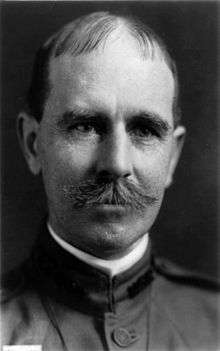John Henry Wigmore
| John Henry Wigmore | |
|---|---|
 John Henry Wigmore | |
| Born |
March 4, 1863 San Francisco, California, U.S. |
| Died | April 20, 1943 (aged 80) |
| Nationality | American |
| Occupation | Jurist |
| Known for | Wigmore chart |
John Henry Wigmore (March 4, 1863 – April 20, 1943) was an American jurist and expert in the law of evidence. After teaching law at Keio University in Tokyo (1889–1892), he was the dean of Northwestern Law School (1901 to 1929). He is most known for his Treatise on the Anglo-American System of Evidence in Trials at Common Law (1904) and a graphical analysis method known as a Wigmore chart.
Personal life and education
Born in San Francisco, son of John and Harriet Joyner Wigmore, Wigmore attended Harvard University and earned the degrees AB in 1883, AM in 1884, and LLB in 1887. Following his graduation, he practiced law in Boston before being recruited as a foreign advisor to Meiji period Empire of Japan, and was assigned to teach law at Keio University in Tokyo from 1889 through 1892.
Keio University
Wigmore's lasting influence is hard to measure in the evolution of legal systems in Japan and the United States. A major legacy of his time in Japan was the beginning of detailed study of the laws of the Tokugawa shogunate in Edo period Japan, which he edited and published as a series of papers while at Keio University. The collection of papers grew to 15 volumes under the collected title of Materials for the Study of Private Law in Old Japan before its completion in the mid-1930s.[1]
Northwestern University
Wigmore accepted a post at Northwestern University and returned to the United States in 1893. He became the dean of Northwestern Law School from 1901 to 1929.
In the 1880s Wigmore was also a leader for election law reform issues such as the secret voting method, and fair ballot access laws. He was also a manager of the 1907-founded Comparative Law Bureau of the American Bar Association, whose Annual Bulletin was the first comparative law journal in the United States.
Wigmore on Evidence
In 1904 he published his most famous work, Treatise on the Anglo-American System of Evidence in Trials at Common Law (usually known as Wigmore on Evidence or just Wigmore), an encyclopedic survey of the development of the law of evidence. Although Wigmore's influence on the modern American law of evidence remains substantial, the primary modern doctrinal basis for the law of evidence in federal trials is the Federal Rules of Evidence, on which many states have modeled their evidence rules.
Select works
- 1891 -- Notes on Land Tenure and Local Institutions in Old Japan: Posthumous Papers of D. B. Simmons (John Henry Wigmore, editor). Tokyo: Asiatic Society of Japan. [reprinted by University Publications of America, 1979. ISBN 978-0-89093-223-0; OCLC 5622796
- 1892 -- Materials for the Study of Private Law in Old Japan. Tokyo: Asiatic Society of Japan. OCLC 26107737
- 1894-- "Responsibility for Tortious Acts: It's History. III", Harvard Law Review, Vol. 7, No. 8, March 25, 1894, pp. 441–463
- 1976 -- Law & Justice in Tokugawa Japan: Contract, Legal Precedents. New York: Columbia University Press. ISBN 978-0-86008-166-1
- 1985 -- Law and Justice in Tokugawa Japan: Contract, Commercial Customary Law. Tokyo: University of Tokyo Press. ISBN 978-0-86008-375-7
- 1986 -- Law and Justice in Tokugawa Japan: Materials for the History of Japanese Law and Justice Under the Tokugawa Shogunate 1603-1867. Tokyo: University of Tokyo Press. ISBN 978-0-86008-396-2
Notes
- ↑ "Edits Japanese Law Data; Prof. Wigmore Completing Work on Records of 1600-1860," New York Times. June 23, 1935.
References
Roalfe, W. R. (1977). John Henry Wigmore, Scholar and Reformer. Evanston, Illinois: Northwestern University Press. ISBN 0-8101-0465-2.
Further Reading
Andrew Porwancher (2016). John Henry Wigmore and the Rules of Evidence: The Hidden Origins of Modern Law. University of Missouri Press.
External links
 Media related to John Henry Wigmore at Wikimedia Commons
Media related to John Henry Wigmore at Wikimedia Commons- John Henry Wigmore Papers, 1868-2006, Northwestern University Archives, Evanston, Illinois